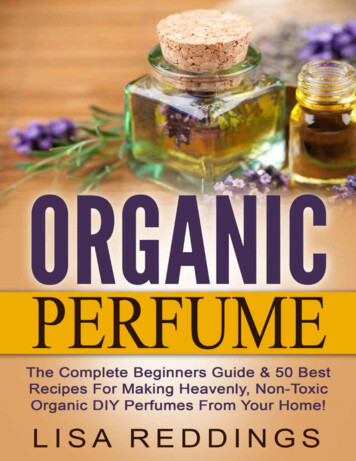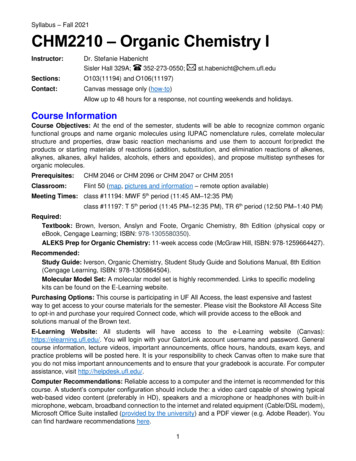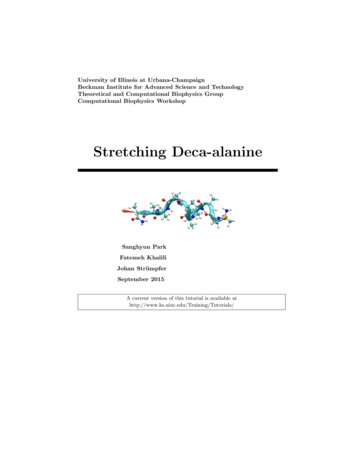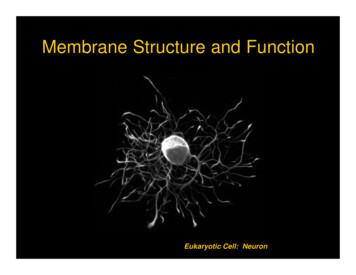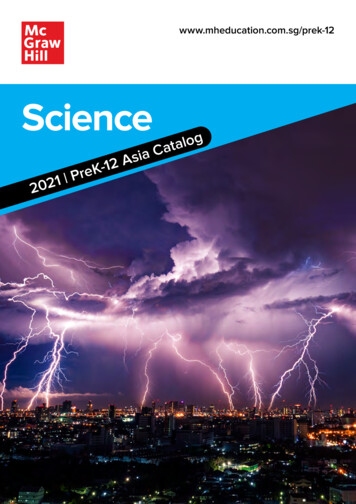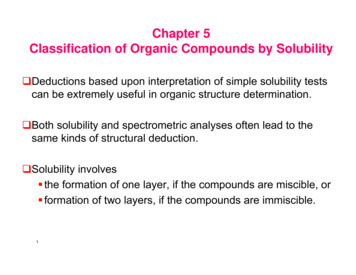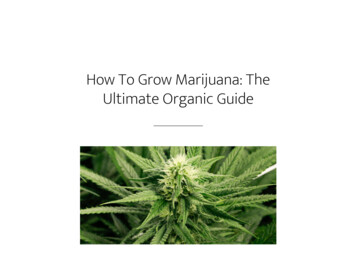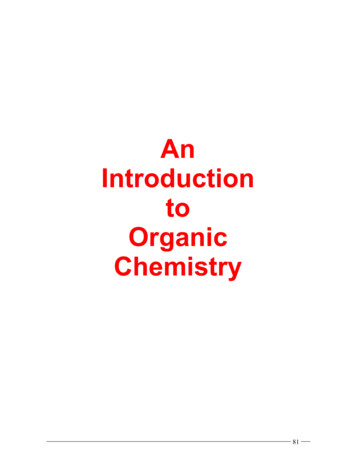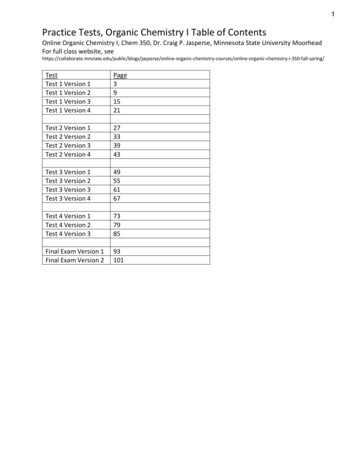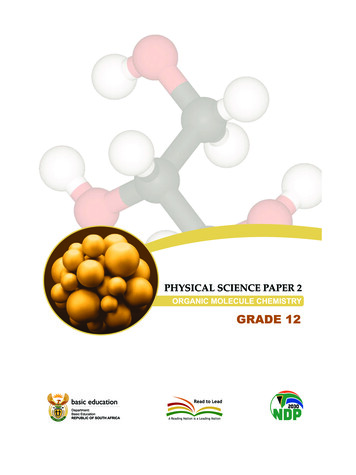
Transcription
ForewordIn order to improve learning outcomes the Department of Basic Education conducted researchto determine the specific areas that learners struggle with in Grade 12 examinations. The researchincluded a trend analysis by subject experts of learner performance over a period of five yearsas well as learner examination scripts in order to diagnose deficiencies or misconceptions inparticular content areas. In addition, expert teachers were interviewed to determine the bestpracticesto ensure mastery of thetopic by learners and improve outcomes in terms of quality andquantity.The results of the research formed the foundation and guiding principles for the development ofthe booklets. In each identified subject, key content areas were identified for the development ofmaterial that will significantly improve learner's conceptual understanding whilst leading to improvedperformance in the subject.The booklets are developed as part of a series of booklets, with each bookletfocussing onlyonone specific challenging topic. The selected content is explained in detail and include relevantconcepts from Grades 10 - 12 to ensure conceptual understanding.The main purpose of these booklets is to assist learners to master the content starting from abasic conceptual level of understanding to the more advanced level. The content in each bookletsis presented in an easy to understand manner including the use of mind maps, summaries andexercises to support understanding and conceptual progression. These booklets should ideallybe used as part of a focussed revision or enrichment program by learners after the topics havebeen taught in class. The booklets encourage learners to take ownership of their own learningand focus on developing and mastery critical content and skills such as reading and higher orderthinking skills.Teachers are also encouraged to infuse the content into existing lesson preparation to ensure indepth curriculum coverage of a particular topic. Due to the nature of the booklets covering onlyone topic, teachers are encouraged to ensure learners access to the booklets in either print ordigital form if a particular topic is taught.
Table of contents2. S tudy and Examination Tips43.1 S ubject specific53.2 T opic specific54. A tomic Theory: its Place in Organic Chemistry64.1 O rganic Chemistry74.1.1 C lassification of hydrocarbons74.1.2 R oot names or prefixes and examples of side chain alkyls74.1.3 S ummary of homologous series84.1.4 E xamples of organic molecules94.1.5 C hain length, and boiling point and melting point of hydrocarbons104.2 B onding in Organic Chemistry114.2.1 T ypes of bonds in organic molecules: Van der Waals forces114.2.2 V an der Waals forces explained124.3 I somers: Isomers means two or more compounds with the same formula,but a different arrangement of atoms in the molecule (structure)and different properties.134.3.1 T ypes of Isomers13Structural isomer13Chain isomers:13Positional isomers14Functional isomers144.4 B oiling point, melting point and vapour pressure164.5 B oiling point, melting point and viscosity in linear hydrocarbons194.5.1 B oiling / melting point and viscosity increase from methane to octane194.5.2 B oiling point, melting point and viscosity in branched hydrocarbons214.6 O rganic reactions4.6.1 E xamples of organic reactions2324Question 2A37Question 7A39Question 6B41Message to Grade 12 learners from the writers45Thank you and acknowledgements45
1. How to use this Study GuideThis book serves as a guide to understanding the Grade 12 Physical Sciences content.However, it does not replace your textbook. The authors have used their experience andfocused their attention on the areas that learners generally seem to struggle with. The bookfocuses on the challenges that have been observed over the past few years with learners’responses in the Grade 12 National Examinations.This guide aims to further explain the concepts dealt with in your regular textbook. It also offersmore exercises and examples, which serve as building blocks to your own understanding ofwhat is expected of you in this subject area. The book draws on basic knowledge acquiredin the lower grades and demonstrates how this knowledge fits in with the new chapters inGrade 12, starting with atomic theory. Figure 1 shows how your study of chemistry is relatedto the atomic theory. The atomic theory is a framework for the whole chemistry curriculum! It istherefore important to remember this theory, as well as the properties of the parts of an atomand the role they play, generally, in chemistry.The chemistry in your textbook is presented in chapters and sections, but remember to integratethese chapters when you answer questions, because everything is interrelated. Science is anexpression of nature, as it draws from nature. Therefore, DO NOT THINK OF CONCEPTS INISOLATION TO THE REST OF THE CHEMISTRY subject! Use the information learnt in othersections to solve the problem at hand!All the questions in this booklet have solutions. Some questions were sourced from pastpapers, while others were sourced elsewhere. Study each question carefully and make sureyou understand the steps taken to solve the question. Then try the rest of the questions, withoutlooking at the solutions. After completion of an exercise, check your solutions against theanswers provided. Move on to the rest of the questions and try to understand why you werewrong when your answer was wrong. Solutions to all exercises are provided in last section ofthis book.Do not hesitate to ask your teacher for help if you struggle with any of the exercises.2. Study and Examination Tips1. P ay attention to your health:2. E at wholesome food - grains, fruit and vegetables - and drink enough water.3. E ngage in light exercise like walking.4. G et enough sleep and rest.5. D evelop a study timetable and try to be disciplined in terms of the times allocated tostudying!3.1 Subject specificAs you prepare to write your examination, it is important that you understand the rulesgoverning certain aspects of your work: definitions, rules, laws and concepts. Understand thesedefinitions/ rules/ laws/ concepts well. Understand what they mean, where they apply andwhen they apply and also when and where they do not apply. Also, always:1. S tart with the questions that you know you are able to answer.2. R ead the question that you are working on carefully.3. U nderstand what it says and what is required of you.4. W rite down the information that you have.1
5. W rite down the information that you do not have.6. U se existing information to derive what you need to solve the question.7. A ll questions have hints that point to the answer.8. C heck your work by going through these steps again.3.2 Topic specificAbout a third of the Physical Sciences Grade 12 Examination Paper 2 comprises OrganicChemistry questions. This booklet provides a few tips that will help you achieve marks inorganic chemistry.This topic requires that you know how to: 1) Name the organic molecules and learn the rulesof naming molecules; 2) The second part requires understanding the reaction of organicmolecules. Pay attention to the names of the reactions, as they provide some explanation aboutthe reactions, e.g. e.g.: hydration means a water (hydro) molecule is added to the molecule inquestion; dehydration means the water molecule is removed.4. Atomic Theory: its Place in Organic ChemistryAtomsMolecules, compounds, gases,solids, liquids, solutions, all materialscontains atoms, organic molecules;inorganic molecules, metalsAccording to the atomic theory,everything around us is mde up ofatoms. Your food, medicine, clothes,furniture, your plants,animals,solutions; all materials around you!Elements(Atoms) in the periodictable naturally occur as elementswithin compounds in nature.Through life processes and industrialprocesses the elements (atoms) canbe separated from compoundsProtonsElectronsNeutrons charge, inside theatom-v charge circling thecentre of the atomneutral, in betweenprotons in the centerof the atomFigure 1: The atomic theory in chemistry 2
Organic compounds comprise the largest group of compounds on earth. Many things aroundyou have carbon as the most abundant atom in them, including food, clothes, paper, coal, fuel,diamonds the list is endless.The carbon atom has wonderful properties that make it bond easily with other carbon atoms andwith other atoms to form short chains and long chains. From methane, a dominant constituent ofmarsh gas to polymers A long time ago, clothes were made from cotton only, which is made up of carbon atoms. Thesecond industrial revolution brought about the process of synthesis, when people realisedthat they can make new products from existing materials and turn the material into somethingcompletely new through a range of reactions that usually mimic something that already existsnaturally. Polymers are such an example. To a large extent, they have replaced cotton throughreactions that produce synthetic materials such as polyester, polyamides, etc. These play animportant role in the clothing industry, and in many other industrial and home products.In South Africa, SASOL produced petrol out of coal. That is the beauty of synthesis: petrol fromcoal and not from oil!4.1 Organic Chemistry4.1.1 Classification of hydrocarbonsHydrocarbonsAlkanesAlkenesSaturated: single Carboncarbon (-C-C-) bonds onlyAlkynesUnsaturated: one or moremultiple carbon-carbon bonds(double or triple bonds)4.1.2 Root names or prefixes and examples of side chain alkylsNumber12345678Root propanebutaneAlkyl CH2CH2CH2CH3
4.1.3 Summary of homologous pExampleStructuralformula of agiven exampleNameending(suffix)AlkanesCnH2n ropyne-yneAlcoholsCnH2n 1OHPropan-1-ol1-propanol-olHaloalkanes CnH2n 1X(Alkylhalides) X F, CI, Bror IAldehydesCnH2nO1-chloro lethanoate-noateEsters4.1.4 Examples of organic moleculesExamples of organic molecules: ethane, propane and methanoic id (CH2O2)CH3CH3CH3CH2CH2ClHCOOH4Molecular Formula: a chemicalformula that indicates the types ofatoms and the correct number of each(atom) in a molecule. Examples: C2H6(ethane), CH2O2 (methanoic acid),C3H7Cl (1-chloropropane).Structural formula: It shows howatoms are attached/ bonded to oneanother within the molecule.Condensed structural formula: anotation that shows how atoms arebonded together in a molecule, but itDOES NOT SHOW ALL bond lines.Molecular model: shows a 3-Drepresentation of organic molecules.
4.1.5 Chain length, and boiling point and melting point of hydrocarbons(Molecules from nonane to eicosane are not examinable.)Saturated Hydrocarbons or olecularFormulaCH4C 2H 6C 3H 20H42Melting 37Boiling te at 25 oCgasliquidsolid4.2 Bonding in Organic Chemistry4.2.1 Types of bonds in organic molecules: Van der Waals forcesHomologous seriesIntermolecularforces acting on thehomologous seriesTypes ofintermolecular forcesand their relativestrengthsAlkanes, Alkenes,AlkynesLondon forcesAldehydes, Ketones,HaloalkanesLondon forcesDipole-dipole forcesLondon forces(dispersion forces/induced dipole forces)The weakestintermolecular forces.The least amount ofenergy is requiredto break theseintermolecular forces.Dipole-dipole forcesStronger than Londonforces, but weakerthan H-bond.More energy isneeded H-bond isrequired to breakthese intermolecularforces than withLondon forces, butless than with H-bond.5Alcohols, CarboxylicacidsLondon forcesDipole-dipole forcesHydrogen bondsHydrogen bondsThe strongestintermolecular forces.The most amount ofenergy is requiredto break theseintermolecular forces.
4.2.2 Van der Waals forces explainedIon-dipoleHydrogen bondDipole–DipoleIon-induced dipoleLondon (dispersion) forcesFormed by the attractionbetween an ion and a polar moleculeInteraction between a chargedion and a molecule that hasa dipole. It is an attractiveforce that is commonly foundin solutions, especially ioniccompounds dissolved in polarliquids.ExamplesNa and H2Omolecules which have H on N,O, or F atomsa weak bond betweentwo molecules resultingfrom an electrostaticattraction between a protonin one molecule and anelectronegative atom in theotherH2O and H2O; H2O andTwo polar molecules with theirnegative and positive endsexperiencing dipole-dipoleattraction.CH3Br and ICl; CH3Br andH2O,hydrogen chloride (HCl): therelatively positive end of apolar molecule will attractthe relatively negative end ofanother HCl moleculeIntermolecular ForcesThe London dispersion forceis the weakest intermolecularforce. The London dispersionforce is a temporary attractiveforce that results when theelectrons in two adjacentatoms occupy positionsthat make the atoms formtemporary dipoles. Thisforce is sometimes called aninduced dipole attraction.6CH3CH2OHFe2 and O2CH4 and CH4; F2 and F2; CH4and F2
ActivityConsider the kinds of intermolecular forces present in the following substances:a) CH3Br;b) CH3OH in H2O;c) CH3CH2CH3 in CCl4;d) O2 and Fe2 ;e) CH3Br in H2O;f) CH3CH2CH3 in CH3Cl.4.3 IsomersIsomers means two or more compounds with the same formula, but a different arrangement ofatoms in the molecule (structure) and different properties.4.3.1 Types of IsomersStructural isomer is an organic molecule with the same molecular formula, but a lpropaneChain isomers: Same molecular formula, but different chains, (e.g. molecular formula C4H10):Butane2-methylpropane7
Positional isomers are compounds with the same molecular formula, but different positionsof the side chain, substituents or functional groups on the parent chain, e.g. molecular formula:C3H7Cl and eneSee the position of chlorine in the first molecule and the second molecule.See the position of double bonds in but-1-ene and but-2-ene.Functional isomers are compounds with the same molecular formula, but different functionalgroups, e.g. molecular formula: C2H4O2 for both molecules that have different structures andtherefore different functional groups.methyl methanoateethanoic acidBoiling point is the temperature at which the vapour pressure of a substance equalsatmospheric pressure. (The stronger the intermolecular forces, the higher the boiling point.)Melting point is the temperature at which the solid and liquid phases of a substance are atequilibrium. (The stronger the intermolecular forces, the higher the melting point.)Vapour pressure is the pressure exerted by a vapour at equilibrium with its liquid in a closedsystem. (The stronger the intermolecular forces, the lower the vapour pressure.)The vapour pressure decreases with an increase in molecular mass/ carbon chain length/number of carbons.Increase in boiling point results in a decrease in vapour pressure (from methane to octane).Therefore, compounds with a lower boiling point will have high vapour pressure, e.g. petrol,which has a lower boiling point than water, will have a higher vapour pressure.Vapour pressure will increase from octane heaviest alkane to methane lightest alkane.Boiling/ melting point and viscosity increase from methane to octane.The same will be true for all other homologous series.8
4.4 Boiling point, melting point and vapour pressureMethane, ethane, propane, butane, pentane, hexane, heptane and octane C arbon chain length and therefore molecular mass increases from methane to octane. I ntermolecular forces increase with an increase in molecular mass/ carbon chain length. T he stronger the intermolecular forces the more energy will be required to break them(London/ dispersion/ induced dipole force).Vapour pressureIncreases with an increase in branching (of the carbon chain).ORIncreases with a decrease in the exposed surface area.Vapour pressure decreases from 2,2-dimethylpropane topentaneThe converse is also true the vapour pressure of a straight chainisomer is lower than that of its branched isomer.Methane, ethane, propane, butane, pentane, hexane, heptane and octane C arbon chain length and therefore molecular mass increases when moving from left of arrowabove to right along the from methane to octane. I ntermolecular forces increase with an increase in molecular mass/ carbon chain length. T he stronger the intermolecular forces, the more energy will be required to break theintermolecular forces (London/ dispersion/ induced dipole force).Boiling/melting point and viscosity increase from methane to octane.The same will be true for all other homologous series.Vapour pressureIt decreases with an increase in molecular mass/ carbon chainlength/ number of carbons.An increase in boiling point results in a decrease in vapour pressure (from methane to octane).Therefore, compounds with a lower boiling point will have high vapour pressure (e.g. petrol,which has a lower boiling point than water, will have a higher vapour).Methane, ethane, propane, butane, pentane, hexane, heptane and octane.Vapour pressure will increase from octane to methane.Consider the structural isomers of C5H12.Pentane2-Methylbutane92,2-dimethylpropane
Vapour pressureThese will decrease with an increase in branching (of carbonchain).ORThese will decrease with a decrease in exposed surface area.The converse is also true the boiling point of a straight chain ishigher than that of its branched isomer.Pentane, 2-Methylbutane and 2,2-dimethylpropaneBoiling point increases from 2,2-dimethylpropane to pentane B ranching increases from Pentane to 2,2-dimethylpropane. T he intermolecular forces decrease from pentane to 2,2-dimethylpropane. I ntermolecular forces decrease with an increase in branching. T he weaker the intermolecular forces, the less the amount of energy required to break theintermolecular forces (London / dispersion/ induced dipole force).Boiling/ melting point and viscosity decrease from pentane to 2,2-dimethylpropane.The same will be true for all other homologous series.Vapour pressureIt will increase with an increase in branching (of carbon chain).ORIt will increase with a decrease in the exposed surface area.Vapour pressure decreases from 2,2-dimethylpropane topentaneThe converse is also true the vapour pressure of straight chainisomer is lower than that of its branched isomer.10
4.5 Boiling point, melting point and viscosity in branched hydrocarbonsConsider the structural isomers of ing point increases from 2,2-dimethylpropane to pentanePentane, 2-Methylbutane and 2,2-dimethylpropaneBranching increases from Pentane to 2,2-dimethylpropane. T he intermolecular forces decrease from pentane to 2,2-dimethylpropane. I ntermolecular forces decrease with an increase in branching. T he weaker the intermolecular forces, the less the amount of energy required to break theintermolecular forces (London / dispersion/ induced dipole force).Boiling/ melting point and viscosity decrease from pentane to 2,2-dimethylpropane.The same will be true for all other homologous series.11
4.6 Organic liminationCrackingALKENE ALKANEEsterficationESTER4.6.1 Examples of organic reactions1. Substitution reactions: Compounds with SINGLE BONDS (alcohols, alkanes orhaloalkanes) form compounds with SINGLE BONDS from a different homologous series(alcohols or haloalkanes).Type of substitutionExampleReaction conditions1.1 H alogenationAlkane to HaloalkaneHeat/ sunlight/ UV light1.2 H ydrolysisHaloalkane to alcoholExcess H2O mild heat1.3 H ydrolysisHaloalkane to alcoholDilute strong base (NaOH /KOH / LiOH) mild heat1.4 A lcohol toHaloalkaneHeat12
2. Addition reactions: Compounds with DOUBLE BONDS (alkenes) form compounds withSINGLE BONDS (alcohols, alkanes or haloalkanes)Type of substitutionExampleReaction conditions2.1 Hydrationexcess H2O; small amount ofacid(H2SO4/H3PO4) as catalyst2.2 HalogenationUnreactive solvent2.3 HydrohalogenationNo water; unreactive solvent2.4 HydrogenationPt, Pd or Ni as catalyst13
3. Elimination reactions: compounds with SINGLE BONDS (alcohols, alkanes orhaloalkanes) form compounds with DOUBLE BONDS (alkenes)Type of substitutionExampleReaction conditions3.1Dehydrohalogenationconcentrated strong base(NaOH / KOH / LiOH) inethanol heat3.2 Thermal crackingheat high pressure3.3 Catalytic crackingheatCH3CH2CH2CH3CatalystCatalyst (alumina, silica), heatCH3CH3 CH2 CH2ethaneethene3.4 Dehydration3.5 DehydrogenationDehydrating agent(H 2SO4/H3PO4) heatCH3CH2CH3CH2 CH2 H2Catalyst (Pt)4. Reactions of alcohols and carboxylic acids (Esterification)Type of substitutionExampleReaction conditionsEsterificationconcentrated sulphuric acidas catalyst heat14
4.7 Macromolecules and PolymersA macromolecule is a molecule that consists of a large number of atoms. A macromolecule is a very large molecule, such as protein, which is commonly created bythe polymerization of smaller sub-units (monomers). The most common macromoleculesin biochemistry are: biopolymers (nucleic acids, proteins, carbohydrates and lipids); largenon-polymeric molecules (such as lipids and macrocycles), and carbohydrates (polymers ofsimple sugars.A polymer is a large molecule composed of smaller monomer units that are covalently bondedto each other in a repeating patternMonomerEthenePolymerpoly(ethene)Repeat unit:See how the bonds breaks during polymerisation. POLYETHENE on the right does not havedouble bonds. It takes its name from the molecule ethene, the molecules from which it started(NOT POLYETHANE).A monomer is a small organic molecule that can be covalently bonded to each other in arepeating pattern. In the example above, ethane is the monomer.Polymerisation is a chemical reaction in which monomer molecules join to form a polymer.Addition polymerisation: A reaction in which small molecules join to form very large moleculesby adding double bonds.Condensation polymerisation is when molecules of two monomers with different functionalgroups undergo condensation reactions with the loss of small molecules, usually water.A carboxylic acid monomer and an alcohol monomer can join in an ester linkage. They areall joined by ester linkages, the polymer chain is a polyester.15
ACTIVITY AQuestion 1Next to each letter in the table below (A – F) is the molecular formula of an organic compound.AC2H5BrBC 2H 4CC4H10DC2H6OEC 2H 6OFC2H6O21.1 C hoose a molecular formula from the list above that represents the organic compoundindicated below.Write down only the letter (A to F) next to the question number (2.1.1 to 2.1.5), e.g. 2.1.6 G.1.1.1 haloalkane1.1.2 alcohol1.1.3 unsaturated hydrocarbon1.1.4 aldehyde1.1.5 A product of thermal cracking of compound C.1.2 I f compound F is a carboxylic acid, write down the following:1.2.1 The structural formula of the FUNCTIONAL isomer of F.1.2.2 The IUPAC name of the FUNCTIONAL isomer of F.(1)(1)(1)(1)(1)(2)(2)1.3 C ompound B is a monomer used to make a polymer.Write down the following:1.3.1 The definition of a polymer.1.3.2 The IUPAC name of the polymer.1.3.3 The balanced equation for the polymerisation reaction.(2)(1)(3)1.4 C ompound A is used as a reactant in the production of compound D. Name the type ofreaction that takes place.(1)1.5 C ompound A is used as a reactant in the production of compound D. Name the type ofreaction that takes place.(2)16
Question 2The letters A to G in the table below represent seven organic compounds.ABCDbutaneEGFethyl propanoate2.1. W rite down the following:2.1.1. The name of the homologous series to which compound F belongs.2.1.2. The name of the functional group of compound D.2.1.3. The letter that represents a primary alcohol.2.1.4. The IUPAC name of compound A.2.1.5. The structural formula of the monomer of compound B.2.1.6. The balanced equation, using molecular formulae, for the combustion ofcompound E in excess oxygen.(1)(1)(1)(2)(2)(3)2.2. B riefly explain why compounds C and D are classified as POSITIONAL ISOMERS.(2)2.3. C ompound G is prepared using an alcohol as one of the reactants.Write down the balanced equation for the reaction using structural formulae forall the organic reagents.(7)17
ACTIVITY BQuestion 11. P lease study the vapour pressure versus temperature graph below. It was obtained for fourstraight chain (unbranched) alkanes (P, Q, R and S).ROM P TO S, EACH COMPOUND DIFFERS FROM THE PREVIOUS COMPOUND BY A –CH2 GROUP.The vapour pressures are measured in mmHg. Atmospheric pressure is 76mmHg.1.1 G ive a reason why alkanes are said to be SATURATED.(1)1.2 D efine vapour pressure.(2)1.3 U se the information in the graph above to answer the following questions.1.3.1 What is the effect of an increase in temperature on vapour pressure?Choose from INCREASES, DECREASES or NO EFFECT.1.3.2 Which compound has a boiling point of approximately 68 C? Give a reasonfor your answer.1.3.3 Which compound has the longest chain length? Explain your answer in full.1.4 C ompound A is used as a reactant in the production of compound D. Name thetype of reaction that takes place.1.4.1 Draw the structural formula of the chain isomer of P. Write down the IUPACname of this isomer.1.4.2 How will the vapour pressure of this isomer compare with that of compound P?Choose from: HIGHER THAN, LOWER THAN or EQUAL TO.18(1)(2)(4)(3)(1)
Question 2The table below shows the results obtained from experiments to determine the boiling point ofsome alkanes and alcohols of comparable molecular mass.CompoundCH3CH3Relative molecular mass30Boiling point 2CH2OH741172. D efine the term boiling point.(2)2.1 C onsider the boiling point of each of the four alkanes in the table above.2.2 D escribe the trend in the boiling points.(1)Explain the trend identified in QUESTION 2 in full.(3)2.3 T he boiling point of each alcohol is much higher than that of the alkane of comparablerelative molecular mass. Explain this observation by referring to the type and strength of theintermolecular forces in alkanes and alcohol.(2)19
Question 3The flow diagram below shows how an alcohol (compound P) can be used to prepare otherorganic compounds.The letters A to E represent different organic reactions. X, Y and Z are organic compounds.BAlkene Compound Y(Major product)AECompund PH2 PtDCHBrCompund X(Organic product)Compound Z3.1 I s compound P a PRIMARY, SECONDARY or TERTIARY alcohol? Give a reasonfor your answer.(2)3.2 W rite down the following:3.2.1 The full elimination reaction represented by A.3.2.2 The addition reaction represented by B.3.2.3 The elimination reaction represented by D.(1)(1)(1)3.3 S odium hydroxide is used as one of the reactants in reaction C.3.3.1 What type of reaction takes place here?3.3.2 What is the IUPAC name of a FUNCTIONAL isomer of F?3.3.3 What is the IUPAC name of a FUNCTIONAL isomer of F?(1)(2)(2)3.4 W rite down the FORMULA of the inorganic reactant needed for reaction D.(1)3.5 U sing STRUCTURAL FORMULAE, write down the balanced equation for reaction E.(3)3.6 W rite down the IUPAC name of compound Z.(1)20
Question 4The flow diagram below shows the preparation of the organic compounds when usingCH3CH CH2 as the starting material. X, Y, Z and P represent different organic reactions.CH3CH CH2CH3CHCℓCH3AlcoholZH2SOYAlkene4.1 T o which homologous series does CH3CH CH2 belong?(1)4.2 W rite down the following: The type of reaction of which X is an example. The structural formula and IUPAC name of the alcohol produced during reaction P. The type of reaction of which Y is an example. The function of the acid in reaction Y.(1)(3)(1)(1)4.3 F or reaction Z, write down the following: The NAME of the inorganic reagent needed. TWO reaction conditions needed. A balanced equation for the production of the alkene, using structural formulae.(1)(2)(5)21
CHECK YOUR ANSWERS22
Activity A1.1.1 A1.1.2 D1.1.3 B1.1.4 E1.1.5 B(1)(1)(1)(1)(1)1.2.1 OR1.2.2 M ethyl ethanoateEthyl methanoateOR(2)(2)1.3.1 A large molecule composed of smaller monomer units covalently bonded to each otherin a repeating pattern.(2)1.3.2 P olyethene1.3.3 (1)(3)1.4 S ubstitution/ hydrolysis(1)1.5 A concentrated strong base like NaOH/KOH/LiOH. H eat strongly.(2)[18]23
Question 2A2.1.2.1.1. Alkynes2.1.2. Hydroxyl group2.1.3. C2.1.4. 2-methylpentan-3-one2.1.5.(1)(1)(1)(2)(2)2.1.6. 2C4 H10 13O22.2. Same molecular formula,8CO2 10H2Bal.(3)but different positions of the functional group.(2)2.3.[19]2.1 They have ONLY single bonds between C atoms.ORThey have NO MULTIPLE bonds between C atoms.ORThey contain the maximum number of H atoms bonded to C atoms.(1)2.2 The pressure exerted by a vapour in equilibrium with its liquid in a closed system.mm(2)2.3.1 INCREASES(1)2.3.2 Q It is the temperature where the graph intercepts the dotted line.OR It is the temperature where the vapour pressure of compound Q equals atmosphericpressure/ is equal to 760 mmHg.(2)2.3.3 S At a given temperature, S has the lowest vapour pressure/ highest boiling point. Strongest intermolecular forces/ London forces/ dispersion forces/ induced dipole forces. Highest energy needed to overcome/ break the intermolecu
2. Study and Examination Tips 4 3.1 Subject specific 5 3.2 Topic specific 5 4. Atomic Theory: its Place in Organic Chemistry 6 4.1 Organic Chemistry 7 4.1.1 Classification of hydrocarbons 7 4.1.2 Root names or prefixes and examples of side chain alkyls 7 4.1.3 Summary of homologous series 8 4.1.4 Examples of organic molecules 9 4.

